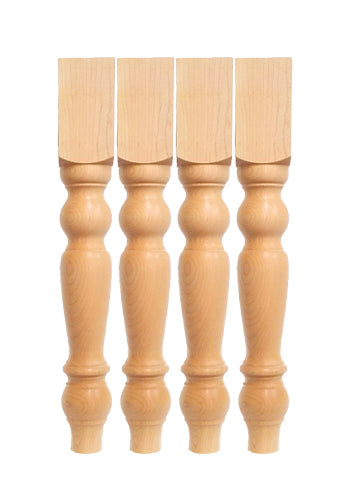Add a Rustic Touch to Your Table with Classic Dining Table Legs Wood
Add a Rustic Touch to Your Table with Classic Dining Table Legs Wood
Blog Article
Trick Elements to Bear In Mind for Eating Table Legs Wood Choices
When picking wood for dining table legs, a number of critical elements call for careful factor to consider to guarantee both performance and visual allure. The selection of timber type, characterized by its toughness and unique grain patterns, plays a critical function in the general style and long life of the item.
Timber Kind and Characteristics
When selecting wood for dining table legs, it is important to comprehend the special attributes of numerous timber kinds. Different woods provide distinct advantages and disadvantages, influencing both the sturdiness and aesthetic charm of the completed product.
Oak, recognized for its excellent sturdiness, also includes a famous grain that can add personality to the table. Cherry wood, with its abundant shade that deepens over time, gives an extravagant look however might require even more maintenance to protect against scrapes.
On the other hand, softwoods like ache and fir are much more affordable and much easier to work with, yet they are much less resilient than woods. Pine is lightweight and includes a warm, rustic look, making it a favored option for casual dining setups. Nonetheless, it is much more vulnerable to damages and scrapes.
Understanding these attributes will certainly assist in making an educated decision to make sure the legs of the dining table satisfy both practical and visual requirements.
Grain Patterns and Aesthetic Appeal
The timber's grain is not merely a visual characteristic; it conveys an unique individuality and appeal to each piece. Different wood types display distinct grain patterns, varying from the straight lines of maple to the intricate swirls of oak and the striking figure of walnut.
Furthermore, the positioning and range of the grain can affect the regarded dimension and sophistication of the table. Larger, more pronounced grains might provide a bold, dramatic result, while finer, subtler grains can develop a fine-tuned, downplayed look. In addition, the completing process can further boost these patterns, highlighting the natural elegance of the wood and bringing out abundant colors.
Eventually, the selection of grain pattern should integrate with various other layout aspects, such as the tabletop and bordering furniture, ensuring a natural visual that raises the dining experience. Thoughtful choice of wood grain not just adds to the table's appeal but likewise reflects the owner's preference and style.
Toughness and Strength
The longevity and stamina of dining table legs are extremely important considerations for making certain longevity and security in any eating area. Choosing the appropriate timber is essential, as various species show differing levels of resilience.

Ultimately, purchasing top notch wood and durable building methods will generate a table that stands the examination of time, while providing a trusted foundation for many dishes shared amongst family and pals. Focusing on toughness and stamina makes sure that your eating table continues to be practical and visually pleasing for years to come.
Maintenance and Treatment
Correct upkeep and treatment are important for preserving her response the resilience and Homepage strength of table legs made from wood. Routine cleaning is crucial; making use of a soft, damp cloth makes certain that dirt and particles do not collect, which can result in scrapes and monotony. It is recommended to avoid harsh chemicals or abrasive products that might damage the surface.
Additionally, using a suitable timber polish or wax occasionally can assist keep the shine and protect the timber from moisture and spills. Nonetheless, it is critical to follow the maker's recommendations regarding the kind of product to utilize, as certain surfaces might react detrimentally to particular chemicals.
Humidity and temperature level changes can additionally affect wood table legs, creating them to warp or crack. It's finest to position the table far from direct sunlight and warm resources. If the table legs have any damages or scratches, attending to these promptly can avoid further damage.
Lastly, regularly evaluating the joints and screws for rigidity is essential to preserve structural stability (Dining Table Legs Wood). By adhering to these maintenance practices, house owners can guarantee their wood table legs stay More hints practical and attractive for several years ahead
Ecological Factors To Consider
When picking timber for dining table legs, it's crucial to take environmental considerations right into account. The sourcing and sustainability of timber are extremely important in minimizing ecological impact. Choosing timber from qualified resources, such as those recommended by the Woodland Stewardship Council (FSC), makes sure that the lumber is collected responsibly, advertising woodland preservation and biodiversity.

In addition, neighborhood sourcing of timber minimizes transport exhausts, sustaining regional economic situations while decreasing ecological influence. It is likewise a good idea to be knowledgeable about the wood's treatment and finishing procedures, as particular chemicals can be harmful to both human health and the environment. By focusing on lasting wood choices, customers can add to environmental preservation while taking pleasure in the durability and beauty of their table legs.
Verdict
In verdict, selecting timber for eating table legs requires mindful consideration of numerous factors, consisting of timber types, grain patterns, and resilience. Upkeep requirements and ecological sustainability further influence wood selections, emphasizing the value of sourcing from certified or reclaimed materials.
When picking wood for eating table legs, several essential aspects necessitate cautious consideration to ensure both performance and visual allure.Proper maintenance and care are crucial for maintaining the resilience and stamina of eating table legs made from timber.When picking timber for eating table legs, it's vital to take ecological factors to consider into account. By prioritizing sustainable wood choices, consumers can add to ecological conservation while taking pleasure in the longevity and beauty of their dining table legs.
In conclusion, selecting wood for dining table legs requires cautious consideration of various elements, including wood types, grain patterns, and durability. Dining Table Legs Wood.
Report this page